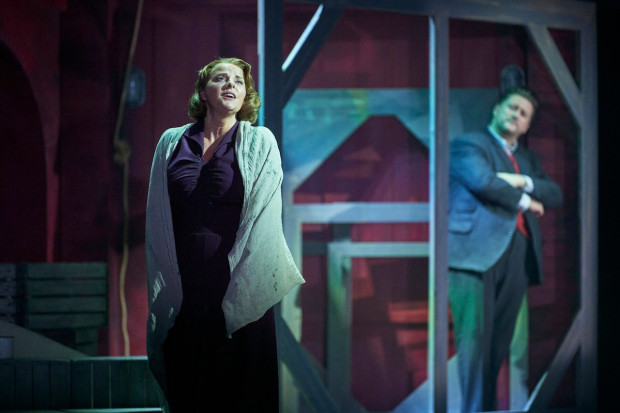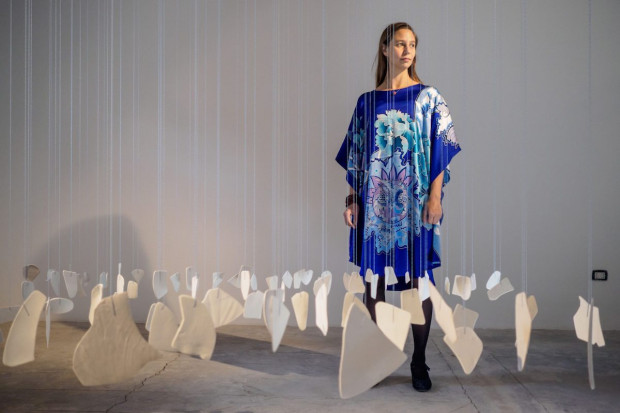
Niamh O'Sullivan as Charlotte in Irish National Opera's 'Werther' (Photo: Pat Redmond)
Conflict and Sorrow in Rural Ireland
Irish National Opera’s currently touring opera is Jules Massenet’s Werther (1887), adapted from Goethe’s novel, The Sorrows of Young Werther. The production premiered in Letterkenny on 22 April before a performance at Solstice Arts Centre, Navan, on the 25th. The Italian tenor Paride Cataldo takes the title role of the morose poet Werther, in love with Charlotte (played by mezzo-soprano Niamh O’Sullivan), who has promised to marry Albert (baritone Charles Rice). Charlotte’s father the Bailiff and her sister Sophie – played by baritone Wyn Pencarreg and soprano Sarah Shine – provide encouragement of the marriage and confidante status respectively. Director Sophie Motley relocates the action from late-eighteenth-century Germany to rural Ireland during the electrification process of the 1950s, and with this change comes some light adaptations of the surtitle translation into English. (Werther, we hear from the comic pair Johann and Schmidt – baritone Owen Gilhooley-Miles and tenor Eamonn Mulhall – rather than being ‘quite melancholy’ is ‘not a lot of craic.’)
Motley’s roots as a theatre director show in a stage that is both focussed and busy; characters in the background are always given something to do while the attention is elsewhere, and there’s a sense of life and activity going beyond the events of the opera. This is particularly true of the first two acts, since the latter two concentrate mainly on individual characters
In fact the solitary interior set of the third act makes quite a stark contrast with the bustling scenes of the first two, with Charlotte alone in her home at Christmas. By all rights, the opera should be called Charlotte. The character spends far more time on stage, and hers is the central conflict in choosing between the man she promised her late mother she’d marry and the manipulative weirdo who spends the whole opera pining for her. She’s also got the most famous aria in the work, ‘Va! laisse couler mes larmes’, an unshakeable staple of the mezzo-soprano repertoire. O’Sullivan did an impressive job here, both before the aria as she tried to put on a brave face for her sister, and in the song itself. She began it with a fiery, almost bitter opening before dwindling to a piteous final cadence.
As Werther, Cataldo is suitably mopey, downcast when he isn’t singing, but his voice rich and confident when it carries his inner thoughts. In the busy first two acts, Wyn Pencarreg sings with charisma and tends to act as a focal point for the action, while Sarah Shine’s sweet-voiced Sophie is affecting, particularly in her duet with Charlotte at the start of act three. (Shine and O’Sullivan have form on stage together, as two of the leads of Donnacha Dennehy’s The First Child. Here their relationship is significantly less fraught.)
Convincing as a chamber opera
Werther is not written for a large orchestra, although the restrictions of staging it in small venues warrant further reductions. The percussion part has been removed entirely, the strings reduced to a sextet, joined by just four woodwinds, harp and a single French horn representing the whole brass section. This sort of ensemble is notoriously tricky to write for. Compared to a full orchestra it has some inherent balance issues, such as the ease with which the French horn or double bass can overpower the other instruments. Irish National Opera’s répétiteur Richard Peirson, who arranged the score, and the conductor Philipp Pointner, deserve substantial credit for making this feel fully convincing as a chamber opera.
That being said, the lack of a pit at the Solstice Arts Centre did cause some issues of balance between the singers and the players. While the melodies were clear, the enunciation was often masked.
It’s in the latter two acts that the work of set designer Sarah Bacon and lighting designer Sarah Jane Shiels comes to the fore. Act three shows us Charlotte’s house with minimalist precision: a Christmas tree tells us the time of year; a painting of the Sacred Heart gives us both location (a Catholic Irish house) and symbolic support for the outpouring of characters’ hearts that takes place in this act; and a shotgun mounted on the wall points to the ending. The set for the last act is almost entirely chiaroscuro, as strong angular white lights cast the characters in an almost film noir hue.
There’s definitely something being said here about the progress of electrification, as the sets and lighting become progressively more electric(-looking). How well it mapped to the plot of Werther, though, was less convincing. While it looked good, and the progression of sets provided its own narrative, it didn’t feel intrinsically linked to the story.
As an organisation, Irish National Opera continues to impress with their standard of performance and their willingness to take risks. Between Werther and Der Rosenkavalier’s Octavian (played by Paula Murrihy) this year, it’s also been nice to have a focus on mezzo-soprano leading roles. It’s unfortunate that the setting didn’t integrate as well as it could have with the work as a whole, but the performance nevertheless left plenty to enjoy for the eyes, the ears, and the mind.
Irish National Opera’s Werther can be seen in Glór in Ennis this evening (4 May), then The Everyman, Cork (Sat. 6 May), Theatre Royal, Waterford (Tues. 9 May), Watergate Theatre, Kilkenny (Thurs. 11 May), and Pavilion Theatre, Dún Laoghaire (Sat. 13 and Sun. 14 May). For booking, visit www.irishnationalopera.ie.
Published on 3 May 2023
Brendan Finan is a teacher and writer. Visit www.brendanfinan.net.















